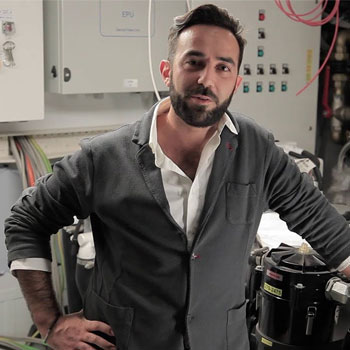
DARWIN CLASS TWIN INDEPENDENT RUDDERS STEERING SYSTEM
Ing. Domenico Ranieri - Technical Departement.

In this article I’ll reveal an important technical aspect of the CdM’s Darwin Class yachts: the system for fully independently control the two semi-balanced rudders and a related trick. Darwin Class have a round displacement hull as all well working work boats, icebreakers, sail boats, big ships, trawlers and explorer yachts. This kind of hull require less power to move and have matchless positive stability.
To have also a good stability of course, the DC have a big inertial moment, a marked bow shape and two skegs that act also as protection for the propellers. Contrarily, this aspect damage the manoeuvrability of the Yacht. To reduce this problem, the naval literature suggest to mount rudders that give big forces at small angles and also for this reason Darwin Class Yachts have two semi-balanced rudders of appropriate area. The traditional systems have the two rudders are connected from a bar that bind the movement to be parallel. This joint is important to move both the rudders from one or two of linear hydraulic actuators and to have a sort of redundancy.
The Darwin Class Yachts’ steering system have the possibility to controlle independently the two rudders. Also if this require a good skill of the
captain, with this solution it’s possible to:
• Dynamically correct geometrical and propulsive asymmetry;
• Fight back forces’ component that rotate the vessel along longitudinal and transversal axis;
• Reduce the derailing during the first phase of the veer;
• Having the rudders at the correct angle respect to the center of the rotation.
This means:
• More speed in rudders response;
• Less veer diameter;
• More safety in all sea condition;
• Automatic re-positioning of the rudders on the 0 angle;
• Less weight and frictions on the steering system.
We’ve registered during the sea trial on hull #1 (M/Y Vitadimare3), that is possible have a 360° rotation at the maximum speed (11.9kn) in just a little bit more than two hull’s length (normal value are between 3 and 7 hull’s length.
Each rudder has its tiller arm moved from one or two hydraulic linear actuators that are electronically controlled by a full follow-up amplifier system. This electronics device permit to operate in either fully synchronized mode (thanks to position sensors and visual indicator in every station) or in indipendent mode for enhanced maneuvering characteristics or dynamic breaking.
This last aspect is very important and consist in moving outboard simultaneuosly both the rudders amplifying the stopping of the vessel as just this arrangement can do. Thanks also to the bow and stern thrusters, you’ll be able to move in very narrow spaces of marinas.
It is also possibile to slightly angle the rudders either in or out to increase propulsive efficiency. Onboard the Darwin Class Yacht you could have up to five helm stations plus one emergency station with an hand pump. The system exceeds worldwide classification requirements of single faiulure criteria for steering system.
YOU MAY LIKE
THESE ARTICLES


